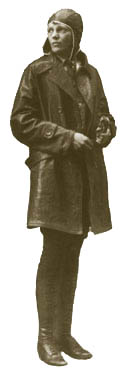Amelia Earhart: Inspiration and Mystery
Part 2: Fame in the Air
In 1922, she began trying to break flying records, most of which were held by men. Long a believer that she could do anything a man could do, Amelia set about trying to make a name for himself by flying. She moved to Boston and continued working to promote the idea of women flying. On April 27, 1926, she began a life totally in the public eye. It was on that day that Captain H.H. Railey called and asked her if she wanted to fly across the Atlantic Ocean. Her answer was, of course, "Yes!" It wasn't the flight that she wanted to make, however. She wasn't in charge, and she didn't really do any of the work. Despite by this time being one of the most famous women in America, she was given the title of "commander" of the mission and sat in a passenger seat while two men, Wilmer Stultz and Slim Gordon, did all of the flying. It was a publicity stunt more than anything else, but the plane, the Friendship, did fly across the Atlantic. Amelia wanted to do it by herself and set about to reach that goal. Charles Lindbergh had made his famous solo flight from New York to France in 1927, one year before Amelia's famous "commander" mission. Amelia, who by this time was nicknamed "Lady Lindbergh," wanted to do just what Lindbergh did—all by herself.
Next page > Bigger and Better Things > Page 1, 2, 3, 4, 5 |
|
Social Studies for Kids
copyright 2002–2024
David White



 Amelia hooked up with Anita "Neta" Snook, a female pilot, who was giving flying lessons. The two got along well together, and Amelia learned a great deal about how to fly. She soon was flying by herself and had even bought a plane.
Amelia hooked up with Anita "Neta" Snook, a female pilot, who was giving flying lessons. The two got along well together, and Amelia learned a great deal about how to fly. She soon was flying by herself and had even bought a plane. She flew by herself across the United States in September 1928, as part of a publicity tour for a book she wrote about her Atlantic flight. She organized a race for women pilots, that went from Los Angeles to Cleveland. (It was after this race that she formed the famous group The 99s, a group made up originally of 99 women pilots.)
She flew by herself across the United States in September 1928, as part of a publicity tour for a book she wrote about her Atlantic flight. She organized a race for women pilots, that went from Los Angeles to Cleveland. (It was after this race that she formed the famous group The 99s, a group made up originally of 99 women pilots.)
